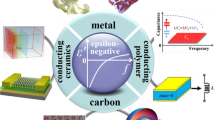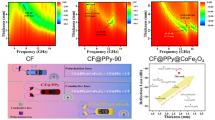Abstract
Negative permittivity is a unique and fascinating property which is essential for applications such as for a perfect lens and 100% electromagnetic wave absorption. Both positive and negative real permittivity are effectively modulated by commercially available low-cost copper microwire epoxy metacomposites. The influence of diameter and length of the copper wire and weight percentage in the polymer composite on the dielectric properties are investigated. Relative real permittivity of 3–240 was obtained in X-band frequency (8.2–12.4 GHz) by controlling the composition of the composites. Ultraweak relative negative permittivity of -5-0 is present for samples of Cu-2mm-70 wt.%/epoxy (EP) or Cu-5mm-50 wt.%/EP composites owing to the low-frequency plasmonic state of free electrons in the percolated networks. The as-prepared Cu/EP composites are promising for microwave manipulating metamaterials and related high-frequency devices.
Graphical Abstract





Similar content being viewed by others
References
X. Zhang, W. Jiang, H. Jiang, Q. Wang, H. Tian, L. Bai, Z. Luo, S. Sun, Y. Luo, C. Qiu, and T. Cui, An optically driven digital metasurface for programming electromagnetic functions. Nat. Electron. 3, 165 (2020).
Z. Wang, K. Sun, P. Xie, Q. Hou, Y. Liu, Q. Gu, and R. Fan, Design and analysis of negative permittivity behaviors in barium titanate/nickel metacomposites. Acta. Mater. 185, 412 (2020).
D. Smith, J. Padilla, D. Vier, S. Nemat-Nasser, and S. Schultz, Composite medium with simultaneously negative permeability and permittivity. Phys. Rev. Lett. 84, 4184 (2000).
D. Schurig, J. Mock, B. Justice, S. Cummer, J. Pendry, A. Starr, and D. Smith, Metamaterial electromagnetic cloak at microwave frequencies. Science 314, 977 (2006).
S. Jahani, and Z. Jacob, All-dielectric metamaterials. Nat. Nanotechnol. 11, 23 (2016).
Z. Shi, R. Fan, Z. Zhang, L. Qian, M. Gao, M. Zhang, L. Zheng, X. Zhang, and L. Yin, Random composites of nickel networks supported by porous alumina toward double negative materials. Adv. Mater. 24, 2349 (2012).
Z. Shi, R. Fan, K. Yan, K. Sun, M. Zhang, C. Wang, X. Liu, and X. Zhang, Preparation of iron networks hosted in porous alumina with tunable negative permittivity and permeability. Adv. Funct. Mater. 23, 4123 (2013).
X. Liu, Z. Ren, T. Yang, Y. Hao, Q. Wang, and J. Zhou, Tunable dielectric metamaterial based on strontium titanate artificial atoms. Scr. Mater. 184, 30 (2020).
H. Moser, B. Casse, O. Wilhelmi, and B. Saw, Terahertz Response of a Microfabricated Rod–Split-Ring-Resonator Electromagnetic Metamaterial. Phys. Rev. Lett. 94, 063901 (2005).
P. Cheben, R. Halir, J. Schmid, H. Atwater, and D. Smith, Subwavelength integrated photonics. Nature 560, 565 (2018).
M. Kadic, G. Milton, M. van Hecke, and M. Wegener, 3D metamaterials. Nat. Rev. Phys. 1, 198 (2019).
S. Venkatesh, Metamaterials and their applications in imaging, The University of Utah, 2017.
D. Estevez, F. Qin, Y. Luo, L. Quan, Y. Mai, L. Panina, and H. Peng, Tunable negative permittivity in nano-carbon coated magnetic microwire polymer metacomposites. Compos. Sci. Tech. 171, 206 (2019).
C. Cheng, Y. Jiang, X. Sun, J. Shen, T. Wang, G. Fan, and R. Fan, Tunable negative permittivity behavior and electromagnetic shielding performance of silver/silicon nitride metacomposites. Compos. A. Appl. Sci. Manuf. 130, 105753 (2020).
L. Sun, Z. Shi, B. He, H. Wang, S. Liu, M. Huang, J. Shi, D. Dastan, and H. Wang, Asymmetric trilayer all-polymer dielectric composites with simultaneous high efficiency and high energy density: A novel design targeting advanced energy storage capacitors. Adv. Funct. Mater. 1, 2100280 (2021).
Q. Jiang, C. Xiang, Y. Luo, L. Wu, Q. Zhang, S. Zhao, F. Qin, and J. Lin, Textile structured metacomposites with tailorable negative permittivity under X and Ku band. Mater. Des. 185, 108270 (2020).
P. Xie, W. Sun, A. Du, Q. Hou, G. Wu, and R. Fan, Epsilon-negative carbon aerogels with state transition from dielectric to degenerate semiconductor. Adv. Electron. Mater. 7, 2000877 (2021).
Z. Shi, R. Fan, Z. Zhang, H. Gong, J. Ouyang, Y. Bai, X. Zhang, and L. Yin, Experimental and theoretical investigation on the high frequency dielectric properties of Ag/Al2O3 composites. Appl. Phys. Lett. 99, 032903 (2011).
Z. Zhang, R. Fan, Z. Shi, S. Pan, K. Yan, K. Sun, X. Liu, X. Wang, and S. Dou, Tunable negative permittivity behavior and conductor–insulator transition in dual composites prepared by selective reduction reaction. J. Mater. Chem. C 1, 79 (2013).
C. Cheng, K. Yan, R. Fan, L. Qian, Z. Zhang, K. Sun, and M. Chen, Negative permittivity behavior in the carbon/silicon nitride composites prepared by impregnation-carbonization approach. Carbon 96, 678 (2016).
P. Xie, Z. Zhang, Z. Wang, K. Sun, and R. Fan, Targeted double negative properties in silver/silica random metamaterials by precise control of microstructures. Research 1, 1021368 (2019).
K. Sun, J. Xin, Y. Li, Z. Wang, Q. Hou, X. Li, X. Wu, R. Fan, and K. Choy, Negative permittivity derived from inductive characteristic in the percolating Cu/EP metacomposites. J. Mater. Sci. Technol. 35, 2463 (2019).
Y. Qu, J. Lin, J. Wu, Z. Wang, K. Sun, M. Chen, B. Dong, Z. Guo, and R. Fan, Graphene–carbon black/CaCu3Ti4O12 ternary metacomposites toward a tunable and weakly ε-negative property at the radio-frequency region. J. Phys. Chem. C. 124, 23361 (2020).
G. Fan, Y. Zhao, J. Xin, Z. Zhang, P. Xie, and C. Cheng, Negative permittivity in titanium nitride-alumina composite for functionalized structural ceramics. J. Am. Ceram. Soc. 103, 403 (2019).
G. Fan, Z. Wang, K. Sun, Y. Liu, and R. Fan, Doping-dependent negative dielectric permittivity realized in mono-phase antimony tin oxide ceramics. J. Mater. Chem. C. 8, 11610 (2020).
Z. Wang, K. Sun, P. Xie, R. Fan, Y. Liu, Q. Gu, and J. Wang, Low-loss and temperature-stable negative permittivity in La0.5Sr0.5MnO3 ceramics. J. Eur. Ceram. Soc. 40, 1917 (2020).
Y. Qu, Y. Du, G. Fan, J. Xin, Y. Liu, P. Xie, S. You, Z. Zhang, K. Sun, and R. Fan, Low-temperature sintering Graphene/CaCu3Ti4O12 nanocomposites with tunable negative permittivity. J. Alloy. Compd. 771, 699 (2019).
Y. Qu, Y. Wu, G. Fan, P. Xie, Y. Liu, Z. Zhang, J. Xin, and Q. Jiang, Tunable radio-frequency negative permittivity of Carbon/CaCu3Ti4O12 metacomposites. J. Alloy. Compd. 834, 1564 (2020).
K. Deepa, M. Sebastian, and J. James, Effect of interparticle distance and interfacial area on the properties of insulator-conductor composites. Appl. Phys. Lett. 91, 202904 (2007).
K. Deepa, S. Nisha, P. Parameswaran, M. Sebastian, and J. James, Effect of conductivity of filler on the percolation threshold of composites. Appl. Phys. Lett. 94, 142902 (2009).
S. George, J. James, and M. Sebastian, Giant permittivity of a bismuth zinc niobite-silver composite. J. Am. Ceram. Soc. 90, 3522 (2007).
Acknowledgments
This work was supported by National Natural Science Foundation of China [51871146, 51803119]; National Key Research and Development Program of China [2021YFE0100500]; Zhejiang Natural Science Foundation [LR20E010001]; Zhejiang Key Research and Development Program [2021C01004]; Chao Kuang Piu High Tech Development Fund [2020ZL012]; Fundamental Research Funds for the Central Universities [2020XZZX002-10]; Aeronautical Science Foundation [2019ZF076002]; China Postdoctoral Science Foundation [2021M692756].
Author information
Authors and Affiliations
Corresponding authors
Ethics declarations
Conflict of interest
The authors declare no conflicts of interests.
Additional information
Publisher's Note
Springer Nature remains neutral with regard to jurisdictional claims in published maps and institutional affiliations.
Rights and permissions
About this article
Cite this article
Ju, L., He, Q., Qin, F. et al. Facile and Efficient Negative Permittivity Realization of Copper Microwire Polymer Metacomposites at X-Band Frequency. J. Electron. Mater. 51, 2107–2113 (2022). https://doi.org/10.1007/s11664-022-09483-0
Received:
Accepted:
Published:
Issue Date:
DOI: https://doi.org/10.1007/s11664-022-09483-0




